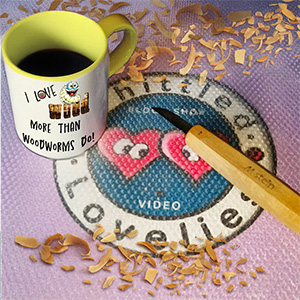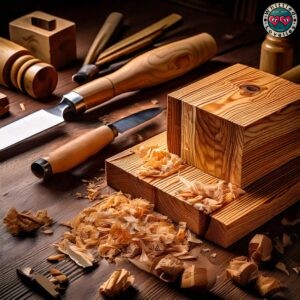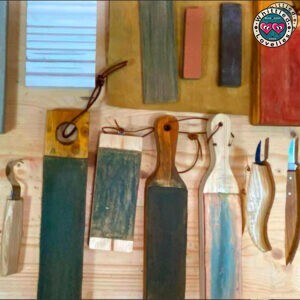Starting out in Woodcarving:
The Things No One Tells You
(But I Wish I Knew)
Published on: May 15, 2025
Reading time: 9 minutes

There’s always that precise moment when the woodcarving bug bites. Sometimes it’s a video on Youtube or a post in Instagram, other times it’s a walk in the woods or a pocket knife you found in your grandpa’s basement that makes you think, “what if I tried this?“
That’s when the spark hits. And if you’re anything like me, from that point on all you think about is actually starting to carve wood, the smell, the feeling of a blade slicing cleanly—and most of all, what you could create with your own hands.
And then… you actually start.
And that’s when you discover the world (beautiful and a bit cruel) of starting out in woodcarving. A world full of things nobody told you. Or maybe they did, but you were too hyped up to listen. So I thought I’d write them down here—plain and simple—like you do when you’ve got something important to tell a friend.
Not because I’ve got all the answers (oh please, no), but because at some point carving becomes this too: telling your story. And maybe laughing about it together. 😉🤫
It’s not just about strength.
It’s about control
Yeah yeah, I know—you’ve heard this before. But trust me, until you’ve got a blade in your hand and a stubborn piece of wood under it, you don’t really get it.
At first, you think, “I just need to push harder.” But the harder you push, the more you slip. And the more you slip, the more you get hurt (or ruin your project, which is sometimes worse). The truth is, wood doesn’t want to be conquered by brute force. It wants you to go with it. Know it. Let it teach you.
Control comes before strength. Actually, real strength is knowing when not to force it. And learning that? Takes longer than you’d think. But you’ll learn it—whether you like it or not.
I learned this the hard way on a piece of maple that was turning out beautifully. I made a long, confident cut, it came out great… and then, all pumped up, I went for another one just a bit deeper. Hit the grain. The result?
A chip as big as my optimism broke off, taking half the face with it (the project’s face, not mine—thankfully 😅). That’s when I realized a knife isn’t just meant to be pushed. It needs to be followed. And you need to learn the cuts if you want to avoid… “going too far”. Which is one of the most common mistakes people make when starting out in woodcarving.
All possible knife cuts of woodcarving!
The perfect wood (universally speaking) doesn’t exist.
(But some woods will definitely make you want to quit)
I have a (mental) list of woods I love and a longer one I never want to touch again (okay, maybe someday! 😇). And it’s not always the hard or “difficult” ones that mess you up. Sometimes it’s the ones that seem soft and easy, but then crumble under the knife or split when you’re nearly done.
Nope, there’s no joy in carving something that crumbles like a stale cookie. Even if it’s “easy to cut,” that doesn’t mean it’s enjoyable. In the beginning, you look for the easiest wood to carve, like there’s some universal answer. Spoiler alert: there isn’t.
Sure, Basswood (Tilia spp.) saves your life most of the time. But then you want to try Hazel (Corylus avellana), Poplar (Populus spp.), Walnut (Juglans regia)… and you realize each wood is a world of its own. Its own smell, its own grain, its own attitude. And then there are the ones you fall in love with even though they clearly don’t love you back. Ever tried Olive wood (Olea europaea)? It’s tough and moody, but so beautiful you forgive everything.
Even when it snaps your carving tools like toothpicks. 🤬🥹
And some… really make you question your life choices. In the end, wood is never just “material.” It’s a mirror. And if you’re stubborn, it’ll match you—maybe even out-stubborn you. But you keep trying to win anyway!
The best woods for carving
Knives aren’t magic wands!
(But they can work magic if you treat them right)
When starting out in woodcarving, it’s easy to assume the tool is everything (and yeah, it really is a lot!). But not quite everything…
When I started, I thought having a knife was enough. In reality, I had super sharp paper cutters, and I thought I was good to go. But then you realize—ergonomics, blade shape, handle size—it all matters.
Then I bought my first real carving knife. Then I bought others. Then I bought the best wood carving knives (for me!). And then I discovered that none of them were going to do the work for me anyway.
A blacksmith once told me: “The perfect knife doesn’t exist.” I doubted it at first, but now I get it—there’s the knife you like. Or more than one. So there’s the right knife for that moment, that hand, that wood, that mood…
And above all: sharpening is not optional. It’s part of the craft.
And I don’t just mean running it on a stone here and there. I mean learning when to sharpen, how to do it without ruining the edge, how much is enough to work well without grinding the whole thing down. Or realizing that actual sharpening is rare, and what really matters is honing—and there’s a big difference!
Sharpening Carving Knives and Woodworking Tools: Complete Guide!
I’ll admit it: I learned to hone only after I started hating my own projects. I couldn’t understand why everything felt like a struggle, even though the knife “seemed” sharp. Seemed. But then I did the paper test (yep, that one from those samurai-cutting videos) and realized my knife was just… dull… but with dignity! 🤣
And remember: every time you think “okay, now it’s sharp,” it could probably be sharper!
That frustration of a blade tearing instead of cutting? Oh, it’s real. It’s silent, sneaky, it gets under your skin and makes you think you’re the problem. But no. It’s just your knife yelling: “Give me a decent honing session, please!” 🙏🏻🥺
The Best Knives for Woodcarving
Carving isn’t just technique.
It’s a quiet transformation
You start with “I want to make this project.” Then it becomes “I can’t get this curve right.” Then “Why is it so crooked?” Then finally: “You know what, I’m doing my own thing.”
And slowly you realize you’re not just learning to carve. You’re learning to observe better. To sit still. To slow down. To let go of perfection. To fix things without ruining them. To start over without giving up.
The first piece you look at like an ugly baby—but it’s yours. The second feels like a masterpiece. The third makes you want to quit… By the tenth, you learn to breathe! And that’s the turning point: when you stop trying to finish and start enjoying the process.
At that point, carving becomes a practice. A form of listening. A way to be present. And honestly, I think that’s a secret no one talks about enough.
The wood listens.
And it answers back
Sounds a bit woo-woo, I know—but it’s true. When you’re tense, the knife skips. When you’re tired, the fibers rebel. When you’re distracted, the wood brings you back to earth with a splinter in your hand, a crack in your project, or a nice slice on your finger.
There are days when everything flows, and others when nothing works. And often it’s not the wood. It’s not the knife. It’s just you!
And the beautiful part is, once you realize that, you also learn to stop. To say, “not today.” And trust me: stopping at the right time saves more projects than any technique ever will.
It’s not just about your hands.
(It’s also about your neck, your back, …)
If you carve at night after a long day, everything changes. If your mind is full, same story. If you carve when angry, you might scrape more of yourself than the wood.
But if you carve in silence, in a good moment, maybe with the right lighting, sitting properly on a good chair… something shifts inside.
There’s a physical strain that creeps in over time and should never be ignored: your neck stiffens, your shoulder locks up, your hand goes rigid. And that’s how you start to get to know yourself. You learn when it’s time to stop and go make a cup of tea—or a good coffee. And yes, in a way, that’s carving too! 😎
You carve alone.
But you’re not really alone
One thing I didn’t expect: carving alone isn’t necessarily lonely. Actually, it’s often the most full moment of the day. Full of gestures, small sounds, thoughts that swirl around and sometimes settle as you cut.
It’s an active silence. Alive. Creative. And even if no one sees it or gets it, you’re doing something that matters.
Even if it doesn’t turn out like you imagined, even if you leave it half-done, even if no one understands it: that gesture has value. You know it. (And so does the wood.) And that’s enough.
Mindfulness: how to achieve it by whittling
The kind of stuff people don’t say enough.
(But it really makes a difference!)
Patience. Not as some abstract virtue, but as a literal muscular skill. Patience is a muscle. And you need it way more than an expensive Japanese knife!
Lighting. Seriously—it sounds silly, but it changes everything. Working with proper side lighting makes you see every detail. Yes, even the flaws. But it still matters—it changes your cuts, for real.
Posture. The difference between one happy hour and three days of neck pain. How many times have you found yourself carving hunched over, one shoulder up, back twisted? Yeah. You’re not alone. But that bad posture? It’ll destroy you in long projects.
The smell of wood. Some woods will make you fall in love, like Juniper (Juniperus communis), others will give you headaches. Yes, carving involves your nose—and by extension, your health. Better to check wood toxicity before it messes you up, right?
The Toxicity of Wood: What You Need to Know Before Working with It and Using It in the Kitchen
Sounds. The sound the blade makes in the wood is different every time—and it’s one of the most beautiful things you can hear. But once you learn to recognize them, you’ll also know when to stop. And stopping in time, before ruining everything? That’s a true pro move!
Shaky hands. Pay attention to the small shifts that happen in you while carving. A shaky hand might be telling you you’re pushing too hard. That it’s time for a break. That maybe it’s not just your wrist asking—maybe it’s your soul. Breathe.
So then…
Why do we keep doing it?
Oh, this is the good part! Just a few reasons (and a little warning: WARNING! May cause addiction!)
- Because sometimes you pull off something you didn’t think you could.
- Because the smell of fresh wood brings you back to life, even on terrible days.
- Because you watch a shape emerge from a block, and in that moment—you feel capable!
- Because time stops—and somehow, you’ve moved forward.
- Because every piece tells a bit of your story. Even if it’s ugly. Even if it’s unfinished.
- You add your own reasons here. And then the most important one:
- Because, despite everything… you’re still not tired of it!
Maybe that’s the real beauty of starting out in woodcarving: you don’t need to be an expert to feel that deep satisfaction that comes after every tiny shaving.
Have you ever had that feeling too? The one that hits right after a splinter under your nail, after a careless cut that makes you think, “Why am I doing this?”… and then a few hours later, you’re still there. Knife in hand. Head full of ideas?
Well, jump in! You’re one of us! 😍🤗 And since you’re here, looks like you’ve landed in the perfect place to feed your curiosity. Why not subscribe to the blog newsletter? You’ll get to read new posts before anyone else! 😉 Link just below! ⬇️ Ciaoooo!
This is an article written by a human for humans!
All articles in the blog are written by me. No contributors, no people paid to write content for me.
Posts written by guests or friends of the blog are marked under the title with the words “guest post.” These are friendly collaborations, contributions to the carving community.
No AI (artificial intelligence) support is employed in the writing of blog articles, and all content is made with the intent to please humans, not search engines.
Do you like my content?
Maybe you can consider a donation in support of the blog!

Click on the link Ko-fi to access a secure payment method and confidently offer me coffee or whatever you want!
From time to time, in articles, you will find words underlined like this, or buttons with the symbol 🛒. These are links that help deepening, or affiliate links.
If you are interested in a product and buy it suggested by me, again at no extra cost to you, you can help me cover the costs of the blog. It would allow me to be able to give you this and much more in the future, always leaving the content totally free.






